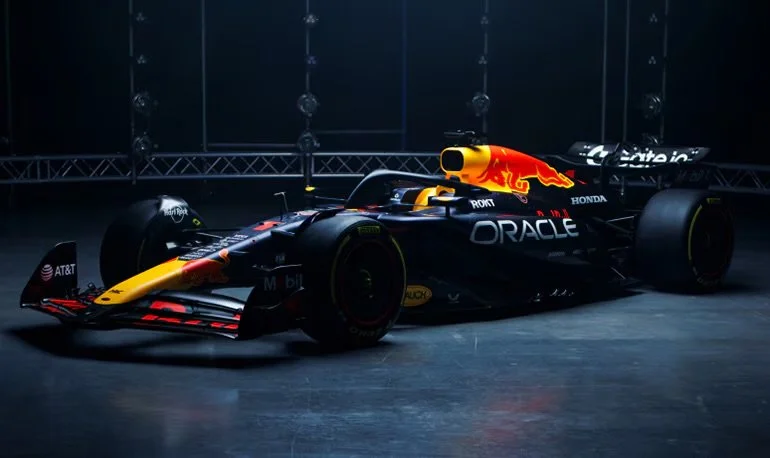THE SPEED OF DATA: WHAT ORACLE RED BULL RACING TAUGHT US ABOUT CREATIVE PERFORMANCE AT GITEX 2025
Formula 1 Getty Images
At GITEX 2025, Oracle demonstrated how data has become the new engine of performance — from Formula 1 strategy to enterprise AI. The Oracle × Red Bull Racing showcase offered a glimpse into how intelligence, not intuition alone, now drives competitive advantage.
Key Points
Oracle’s real-time data ecosystem powers Red Bull Racing’s success — proving that performance today is engineered through analytics, not instinct.
The same principles that define Formula 1 precision now shape creative and strategic decision-making: feedback loops, measurable systems, and AI-informed insight.
The future of innovation lies in systems that learn — where speed, intelligence, and adaptability define who leads the race.
Bungalow 28 attended GITEX 2025 — where Oracle demonstrated how data has become the new engine of performance, from Formula 1 strategy to enterprise AI. Presenting a suite of intelligent tools that plan finances, optimise supply chains, and power the Oracle × Red Bull Racing simulator, the company showed how real-time data on Cloud translates intelligence into measurable results.
The installation wasn’t about spectacle; it was about substance — a tangible illustration of how data performance is reshaping industries, from Formula 1 to global business. As Oracle’s engineers explained how Red Bull Racing’s race strategy is refined through millions of live telemetry points and predictive simulations, the parallel to creative performance became clear.
As Oracle builds intelligence for Red Bull, we apply the same principle to brands — designing systems that learn, refine, and adapt in real time.
The car built by code
In Formula 1, Red Bull’s dominance is no longer purely mechanical. It’s computational.
The partnership with Oracle has redefined how data informs both car design and race strategy. Every lap is a feedback loop — a live conversation between human instinct and machine precision. The car learns. The driver adapts. The algorithm evolves.
This is the essence of modern performance: the intersection of creativity and computation.
Alliances that shape the future
During GITEX, I attended a session titled “Alliances That Shape the Future: Inside the Stargate UAE Partnership Network,” featuring speakers from G42, OpenAI, Cisco, and Oracle.
It was there that Mohamed Taha Benssiba, Oracle’s Head of AI for the Middle East and Africa, described how Oracle’s infrastructure powers Red Bull’s engineering precision — not by building cars, but by building intelligence.
“We’re not just building cars,” he said. “We’re building intelligence.”
In that moment, the connection between data ecosystems and creative ecosystems became unmistakable. Formula 1 teams, like leading agencies, now rely on systems that think — systems that predict, simulate, and adjust in real time.
From aerodynamics to algorithms
Red Bull doesn’t guess; it measures. Every decision — from tyre choice to wing angle — is scenario-tested, modelled, and iterated through Oracle’s data cloud.
Strategy is our aerodynamics — the invisible structure that determines how fast ideas travel.
Data is our wind tunnel — the controlled space where we test, measure, and refine.
Like Red Bull, we believe performance is engineered, not improvised.
The performance mindset
Watching Oracle’s presentation at GITEX, I couldn’t help but see the parallels between sport and creative business. Both are about marginal gains — refining systems until they reach peak precision. Both are about alignment between vision and velocity.
In Formula 1, a tenth of a second defines a season. In brand performance, a one-percent improvement in engagement or conversion can redefine market share.
The differentiator? Data literacy — knowing which signals matter, and how fast you can act on them.
GITEX as a mirror
GITEX this year wasn’t just a technology showcase. It was a mirror — reflecting how creativity, commerce, and computation now operate as one.
The Oracle × Red Bull Racing collaboration embodies this shift perfectly: art meets engineering, speed meets insight. Every decision is measurable, every outcome optimisable. The same precision that wins races is now reshaping how brands grow, storytell, and scale.
This is the new creative frontier — where emotion and algorithm no longer compete, but collaborate.
Beyond the grid
Formula 1 teams don’t win because they build faster cars; they win because they build smarter systems. The same is true in branding. In a saturated landscape, intelligence is the ultimate differentiator.
Data is not the enemy of creativity — it’s its most powerful amplifier.
When Red Bull strategists decide whether to pit or stay out, the decision happens in milliseconds, powered by AI models and human instinct. That agility is what defines the next generation of creative leadership — adaptable, analytical, and alive to real-time context.
The finish line
The future of brand performance won’t be decided by who shouts the loudest, but by who listens the closest — to data, to culture, to behaviour.
As I left GITEX, that one line from Oracle stayed with me:
“We don’t build cars. We build intelligence.”
And that, in essence, is the evolution of modern creativity — where every design, every campaign, every insight is engineered for pure performance.
Because in a world moving at Formula 1 speed, creativity is no longer just an art.
It’s a science of motion.
At Bungalow 28, we bring that philosophy to communication — building systems of influence that perform with precision.
We attended GITEX Global 2025 to explore how emerging technologies are redefining the boundaries between creativity and computation — a vision that sits at the core of everything we do.
Bungalow 28 operates at the intersection of technology and image — offering end-to-end services across fashion, luxury, art, and culture through three distinct verticals.


